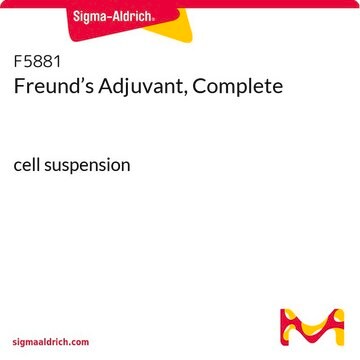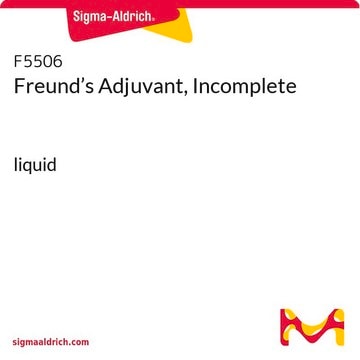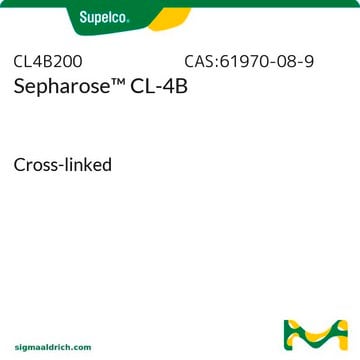Transportation information can be found in Section 14 of the product's (M)SDS.To access the shipping information for this material, use the link on the product detail page for the product.
Kluczowe dokumenty
C9142
Cyanogen bromide-activated-Sepharose™ 4B
lyophilized powder
Synonim(y):
Cyanogen bromide-activated Agarose
Wybierz wielkość
510,00 zł
Wybierz wielkość
About This Item
510,00 zł
Polecane produkty
Formularz
lyophilized powder
metody
affinity chromatography: suitable
Matryca
Sepharose 4B
grupa aktywna macierzy
cyanate or related structures
spacer macierzy
1 atom (when ligands are coupled via isourea derivative or related linkage)
pęcznienie
1 g swells to 4-5 mL
wielkość cząstki
45—165 μm
temp. przechowywania
2-8°C
Szukasz podobnych produktów? Odwiedź Przewodnik dotyczący porównywania produktów
Powiązane kategorie
Opis ogólny
C9142-15G′s updated product number is GE17-0430-01
Zastosowanie
- in the purification of clusterin from serum by an immunoaffinity-based separation procedure
- in affinity chromatography to isolate Leishmania donovani protein antigens from the urine of visceral leishmaniasis patients
- in affinity chromatography for the isolation of haptoglobin from human serum
Postać fizyczna
Informacje prawne
produkt powiązany
zastąpiony przez
Kod klasy składowania
11 - Combustible Solids
Klasa zagrożenia wodnego (WGK)
WGK 3
Temperatura zapłonu (°F)
Not applicable
Temperatura zapłonu (°C)
Not applicable
Środki ochrony indywidualnej
Eyeshields, Gloves, type N95 (US)
Wybierz jedną z najnowszych wersji:
Certyfikaty analizy (CoA)
Nie widzisz odpowiedniej wersji?
Jeśli potrzebujesz konkretnej wersji, możesz wyszukać konkretny certyfikat według numeru partii lub serii.
Masz już ten produkt?
Dokumenty związane z niedawno zakupionymi produktami zostały zamieszczone w Bibliotece dokumentów.
Klienci oglądali również te produkty
-
What is the Department of Transportation shipping information for this product?
1 answer-
Helpful?
-
-
After I've washed and prepared the resin in Product C9142, Cyanogen bromide-activated-Sepharose®, for the coupling reaction, how long can I wait before coupling the ligand to the resin?
1 answer-
We would recommend coupling the ligand immediately after washing and preparing the resin. This is because the reactive groups hydrolyze in the basic solution conditions of the preparation steps. The solutions used in the coupling reaction should also be kept cold (2-8°C) during the procedure.
Helpful?
-
-
Should I use a desiccator environment for storage of Cyanogen bromide-activated-Sepharose®?
1 answer-
It is a good idea to store the CNBr-activated agarose products in as dry an environment as possible, because the reactive groups are very moisture-sensitive.
Helpful?
-
-
How are proteins attached to the Cyanogen bromide-activated Sepharose® in Product C9142?
1 answer-
Coupling of molecules to CNBr-activated Sepharose® is usually via amine groups. In the case of proteins, this usually means the epsilon amines (exocyclic amines) of lysine groups.
Helpful?
-
-
What kind of volume should I use for my ligand to couple to the Cyanogen bromide-activated Sepharose®, Product C9142?
1 answer-
It is best that the coupling ligand should not be in too dilute a solution. In general, a volume ratio of 0.5 to 1 of coupling solution to CNBr-activated Sepharose® is recommended.
Helpful?
-
-
When using Product C9142, Cyanogen bromide-activated-Sepharose®, is there a particular storage buffer that I should use after I've coupled my ligand to the resin?
1 answer-
This depends on the particular situation, and the answer depends more on the coupled ligand than the resin itself. The most important criterion is to choose a buffer that is not harmful to the ligand. It is common to include 20% ethanol or preservatives like sodium azide or thimerosal (~0.02%) to inhibit potential bacterial growth.
Helpful?
-
-
My ligand is in Tris buffer. Can I use Product C9142, Cyanogen bromide-activated-Sepharose®, with this sample?
1 answer-
Because Tris is an amine-containing buffer, we do not recommend coupling of samples in Tris buffer to the CNBr-activated Sepharose®. Tris will react with the CNBr groups and remove sites for ligand coupling. We would not recommend use of any amine-containing buffer in the coupling reaction. However, after the ligand has been added in the coupling reaction, then it is OK to use amine-containing buffers to block the remaining sites (e.g. ethanolamine, glycine).
Helpful?
-
Active Filters
Nasz zespół naukowców ma doświadczenie we wszystkich obszarach badań, w tym w naukach przyrodniczych, materiałoznawstwie, syntezie chemicznej, chromatografii, analityce i wielu innych dziedzinach.
Skontaktuj się z zespołem ds. pomocy technicznej














